Elizabeth Zhou, Year 2 Research.
Abstract
This study aimed to identify a relationship, if any, between exercise and working memory. Working memory, which may also be referred to as short-term memory, describes the mechanisms that allow someone to recall a series of events or instructions. Three memory tests were used in this study, and each test was given twice – once before a short period of exercise and once after. The results from this study are inconclusive but may indicate a negative relationship between stress (indicated by an activated sympathetic nervous system) and working memory.
Introduction
For decades now, the Intelligence Quotient, or IQ, has been used as a metric for childhood development (Martschenko, 2018), however, working memory capacity – the mechanisms that allow someone to recall a series of events or instructions – may be a better indicator of classroom performance (Clair‐Thompson et al., 2010; Gathercole et al., 2008). Gaining more knowledge on cognitive development is crucial in setting up future generations for success; by exploring how short-term exercise affects working memory, parents and childcare staff may better understand how children and adolescents think, and adjust their methods of guidance accordingly.
This study aims to identify a positive relationship between working memory capacity and short-term exercise by measuring individual performance on three short working memory tasks before and after an exercise period. Previously, researchers have tested the effects of physical exercise on working memory in post-stroke patients (Moriya et al., 2016). Although this study is also testing the effects of physical exercise on working memory, the group of interest is adolescents, not stroke patients. The results of Moriya’s study show very strong evidence (p < 0.01) indicating that physical exercise improves performance on working memory tasks; since the age difference between their target population and that of this study is large, similar, but not identical, results are to be anticipated. Since several studies indicate that working memory plays a significant role in typical classroom activities that involve both the storage and mental manipulation of information (Clair‐Thompson et al., 2010; Gathercole et al., 2008), this study aims to reinforce that exercise is pivotal in childhood academic development.
Materials and Methods
The three memory tasks for the study — delayed recall, card matching, and tray recall — were decided upon and prepared. For the delayed recall, two five-digit numbers (68941 and 36247) were randomly generated and written down.
For the card matching, twenty-five playing cards (twelve pairs from A to Q with one odd K) were randomly configured into a 5 x 5 flatlay. The locations of each card were recorded so the task could be repeated for each participant without external confounding variables. Once recorded, the same twenty-five cards were randomly put into another configuration, where their locations were recorded again.
For the tray recall, twenty-one random items were obtained. These twenty-one objects were divided into two groups of eleven objects, and a picture was taken of each group (see Figure 1 and Figure 2).
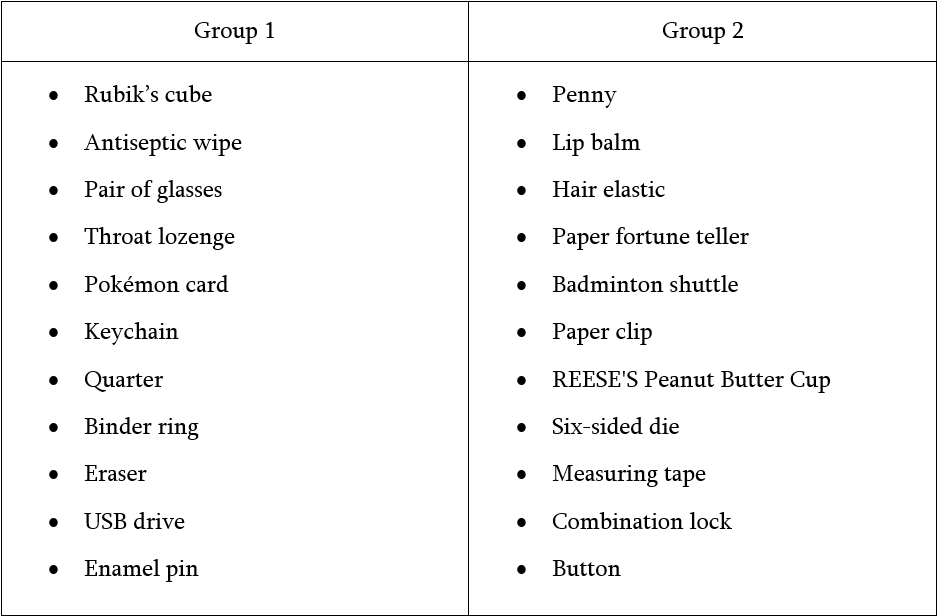
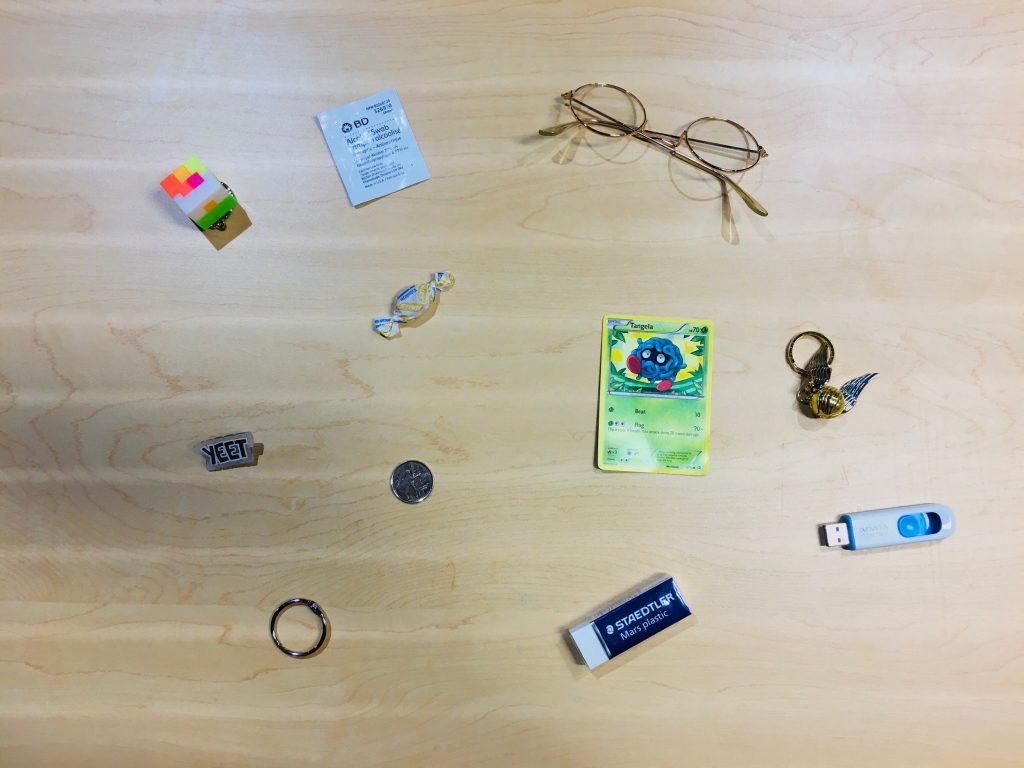
Figure 1. One of two flatlays used in the Item Recall Task. From top to bottom, left to right, the objects include: a Rubik’s cube, an antiseptic wipe, a pair of glasses, a throat lozenge, an enamel pin, a quarter, a Pokémon card, a keychain, a binder ring, an eraser, and a USB drive.
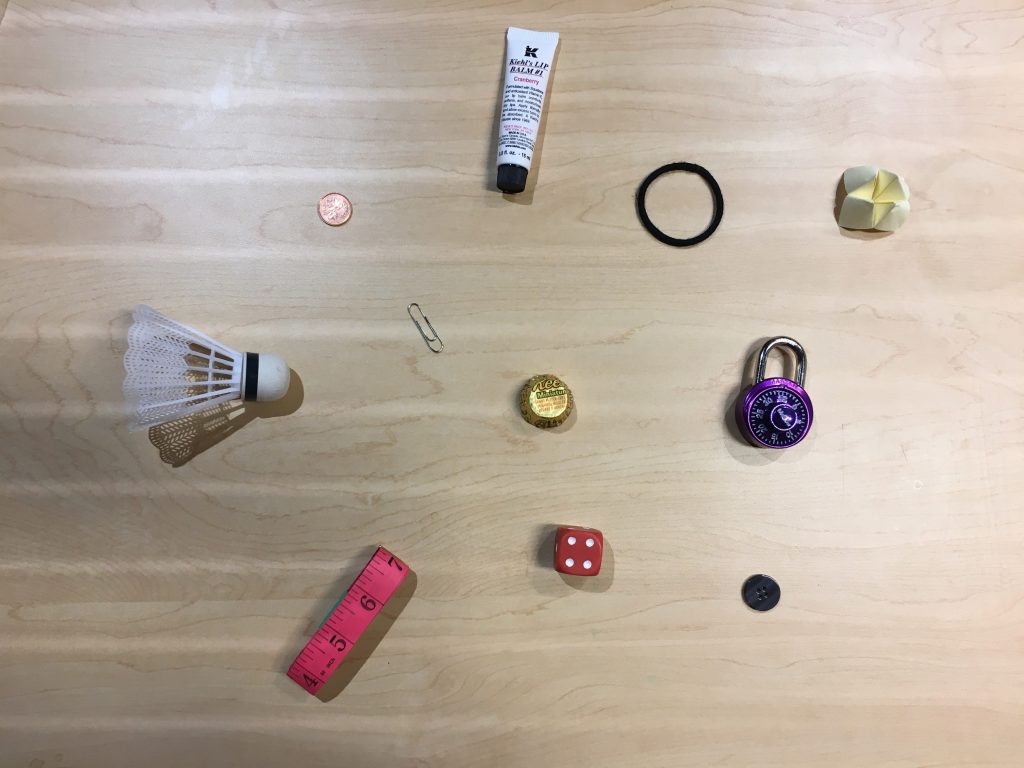
Figure 2. The second flatlay of eleven items used in the Item Recall Task. From top to bottom, left to right, the objects include: a penny, lip balm, a hair elastic, a paper fortune teller, a badminton shuttle, a paper clip, a REESE’S Peanut Butter Cup, a combination lock, a measuring tape, a six-sided die, and a button.
Since the study required human participants, a consent form was created. The form required participants to answer one demographics question: how much they exercised per week. The three options were: Frequently – over three times a week, Fairly Frequently – one to three times a week, and Infrequently – zero times a week.
During the study, the consent form would first be signed by each participant, then one of the two five-digit numbers would be told to the participant. Next, the participant would be presented with one of the two flatlays of playing cards and they would be tasked with matching all the pairs by picking up two cards at a time, keeping them if they matched, and placing them down again if they did not match. Afterwards, participants would be shown a picture of eleven items on a desk (either Figure 1 or Figure 2), and they would have 25 seconds to look at the picture before having to write down as many objects as they remembered. Finally, participants would be asked to repeat the five-digit number to the researcher, if they were able to remember it.
After the three memory tasks were completed, the participant would be told to do vigorous jumping jacks for 30 seconds. Immediately afterwards, the participant would repeat the same three memory tasks, this time with the other five-digit number, the other array of cards, and the other set of items.
Results
In response to the demographic question given to participants before the memory tasks, 3 out of 21 participants indicated that they exercise over three times a week, 12 out of 21 participants indicated that they exercise one to three times a week, and 6 out of 21 participants indicated that they generally do not exercise during the week. Initial performance results for each group are as follows: Those who exercise frequently averaged 83.7 seconds for the card matching task, 9.3 items for the item recall task, and 4.3 numbers for the five-digit recall task. Those who exercised fairly frequently averaged 114.7 seconds for the card matching task, 8.2 items for the item recall task, and 4.4 numbers for the five-digit recall task. Those who exercised infrequently averaged 112.7 seconds for the card matching task, 7.7 items for the item recall task, and 5 numbers for the five-digit recall task.
For the card matching task (Figures 3 and 4), there is a general trend of participants matching all the cards faster in Trial 2 than in Trial 1. The average time to complete the task dropped by 24 seconds, and only 4 out of 21 participants had their Trial 2 time exceed their Trial 1 time. Out of these four trials, only one participant’s time was over ten seconds slower for their second trial.
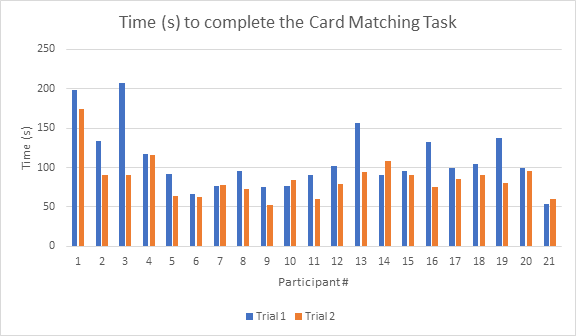
Figure 3. A chart depicting the time in seconds it took for each participant to complete the card matching task. Participants 7, 10, 14, and 21 completed the task slower in Trial 2 than in Trial 1.
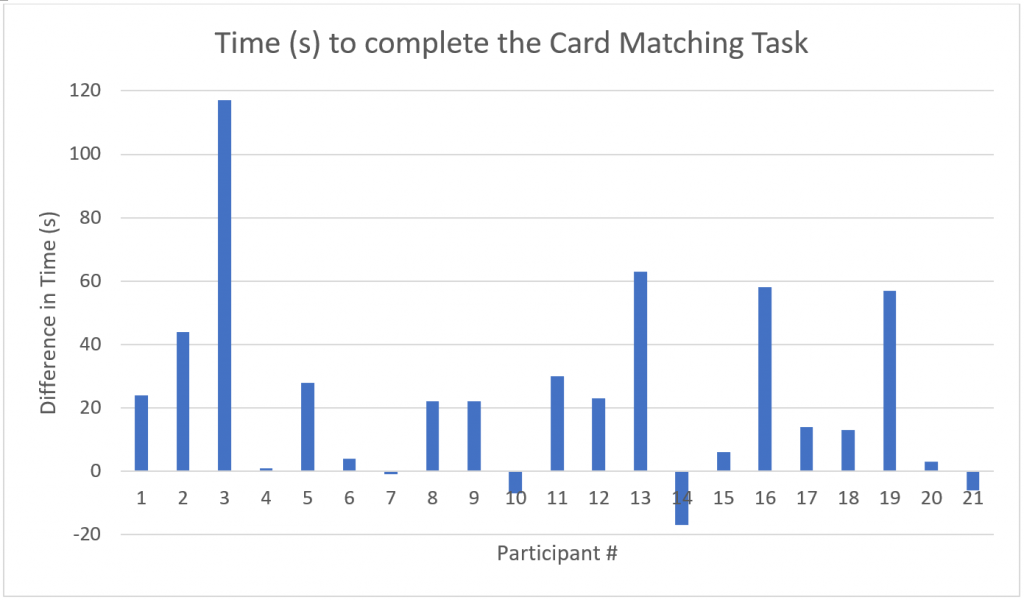
Figure 4. A chart depicting the difference in time (seconds) between Trial 1 and Trial 2. A positive value indicates improvement; the participant completed Trial 2 faster than Trial 1.
In the item recall task (Figures 5 and 6), the average number of items recalled dropped by 1 from Trial 1 to Trial 2. 14 out of 21 participants recalled fewer items, 3 out of 21 participants recalled the same number of items, and 4 out of 21 participants recalled more items.
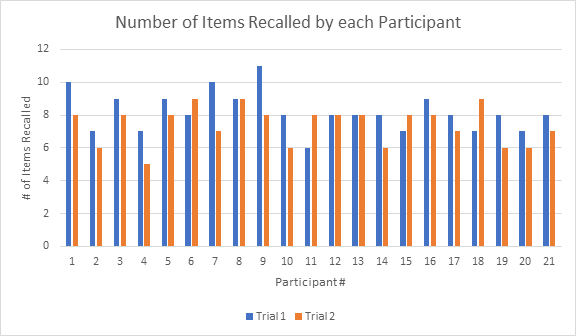
Figure 5. A chart depicting the number of items each participant was able to correctly write down in the item recall task. 14 out of 21 participants recalled fewer items, 3 out of 21 participants recalled the same number of items, and 4 out of 21 participants recalled more items.
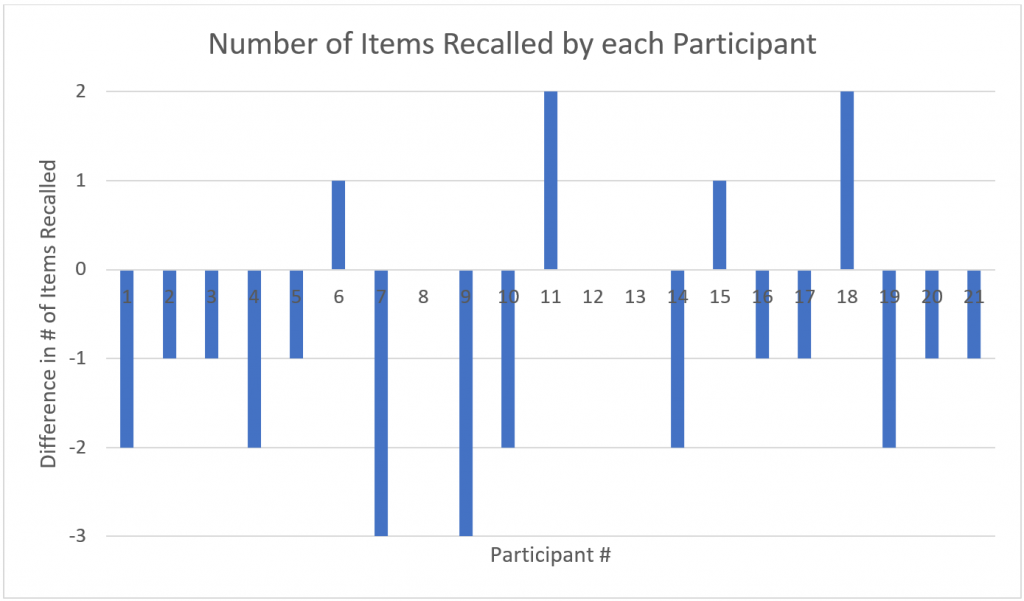
Figure 6. A chart depicting the difference in the number of items that each participant remembers between Trial 1 and Trial 2. A positive value indicates improvement; the participant remembered more items in Trial 2 than in Trial 1.
For the five-digit recall task (Figures 7 and 8), the average number of digits recalled dropped by 2 from Trial 1 to Trial 2. In Trial 1, only 3 out of 21 participants did not recall all five digits. However, in Trial 2, 12 out of 21 participants were not able to recall the five-digit number. Of the 12 participants in that group, 8 participants could not even remember three of the digits. None of the participants scored better in Trial 2 than in Trial 1.
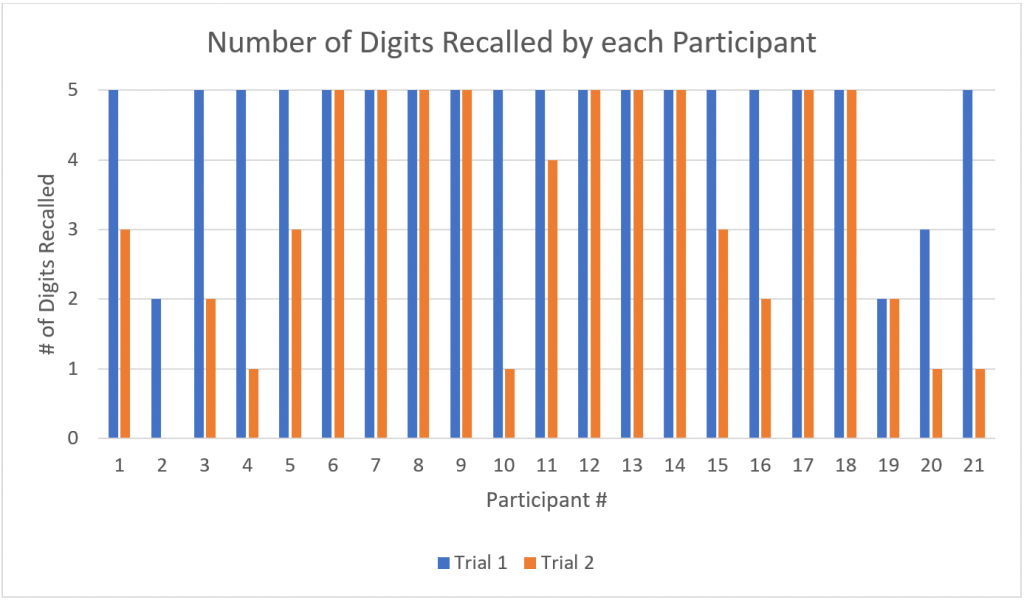
Figure 7. A chart depicting the number of digits each participant was able to correctly recall in the five-digit recall task. Only participants 2, 19, and 20 were unable to recall all five digits in Trial 1.
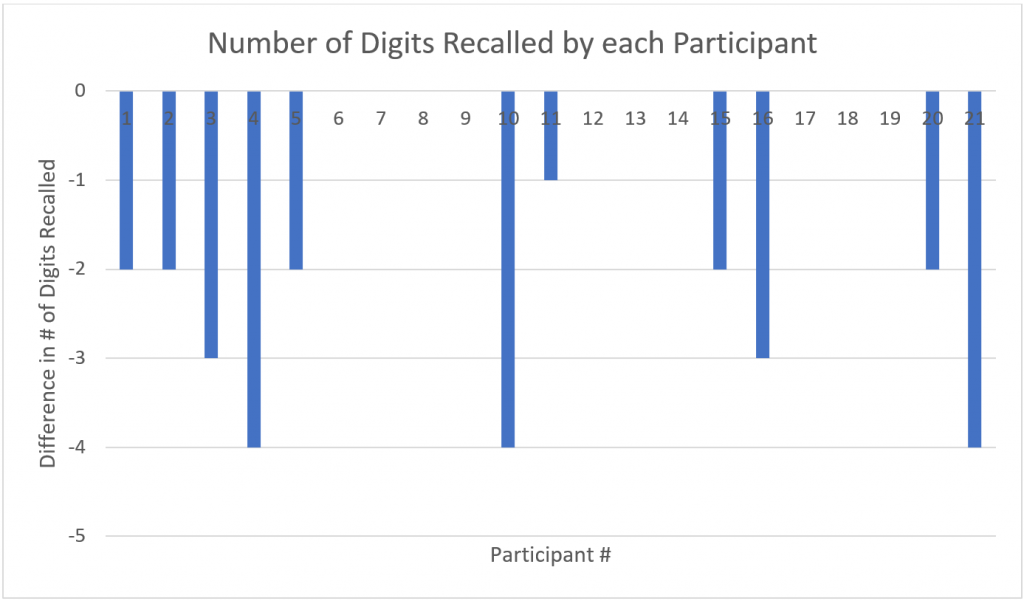
Figure 8. A chart depicting the difference in the number of digits that each participant remembers between Trial 1 and Trial 2. A negative value indicates deterioration; the participant remembered fewer digits in Trial 2 than in Trial 1.
Discussion
The fact that participants performed better in the card matching task and worse in the item and number recall tasks may lead one to believe that the results are inconclusive. Alternatively, one possible explanation for the seemingly inconclusive results is that exercise activated the participants’ sympathetic nervous response due to their increased breathing rate. This would explain why participants would do better on a more dexterous task such as the card matching, but worse on physically idle tasks such as the recall tasks. This is similar to the findings of the study done by Clair‐Thompson et al. (2010), which show improvements in tasks assessing following instructions, but no improvements on standardized tests of reading or mathematics. However, this explanation does not indicate any meaningful relationship between exercise and working memory for the card matching task, as the time improvement in Trial 2 could be due to increased dexterity in picking up the cards instead of improved memory. This counts as a source of error, and if this study were to be repeated, recording the number of flips until all pairs are matched would be a better indicator of working memory.
To find a relationship between exercise and working memory, it may be better to look at the data for the two recall tasks. The results from those two tasks seem to indicate that sudden activity before memory tests actually has a negative effect on working memory. In this case, it is important to note that it is more likely for the other physiological factors such as elevated heart rate and breathing rate — not exercise — to have a negative effect on working memory. This assessment is supported by the study done by Schoofs et al. (2009), where working memory capacity decreased when heart rate increased. Moreover, the demographics of this study can be compared with the results of the memory tests; those who do not exercise at all recall an average of 7.7 items in Trial 1 of the item recall, whereas those who exercise fairly frequently and those who exercise frequently recall an average of 8.2 and 9.3 items, respectively. This conversely indicates that moderate exercise, over a long-term period, may result in improved working memory. Thus, if one wanted to test for exercise’s effects on working memory, the study should be modified to be longitudinal, if possible.
While the intention was to record the heart rate of each participant before and after exercise, the researcher did not have reliable equipment that could provide accurate and consistent readings. Because of this, the study was adapted, and each participant was told to do the same exercise for a designated amount of time. One final consideration for a future study would be to quantifiably measure the heart rate of participants.
References
Clair‐Thompson, H. S., Stevens, R., Hunt, A., & Bolder, E. (2010). Improving childrens working memory and classroom performance. Educational Psychology, 30(2), 203–219. doi: 10.1080/01443410903509259
Gathercole, S. E., Durling, E., Evans, M., Jeffcock, S., & Stone, S. (2008). Working memory abilities and childrens performance in laboratory analogues of classroom activities. Applied Cognitive Psychology, 22(8), 1019–1037. doi: 10.1002/acp.1407
Martschenko, D. (2018, February 1). The IQ test wars: why screening for intelligence is still so controversial. Retrieved from https://theconversation.com/the-iq-test-wars-why-screening-for-intelligence-is-still-so-controversial-81428
Moriya, M., Aoki, C., & Sakatani, K. (2016). Effects of Physical Exercise on Working Memory and Prefrontal Cortex Function in Post-Stroke Patients. Advances in Experimental Medicine and Biology Oxygen Transport to Tissue XXXVIII, 203–208. doi: 10.1007/978-3-319-38810-6_27
Schoofs, D., Wolf, O. T., & Smeets, T. (2009). Cold pressor stress impairs performance on working memory tasks requiring executive functions in healthy young men. Behavioral Neuroscience, 123(5), 1066–1075. doi: 10.1037/a0016980